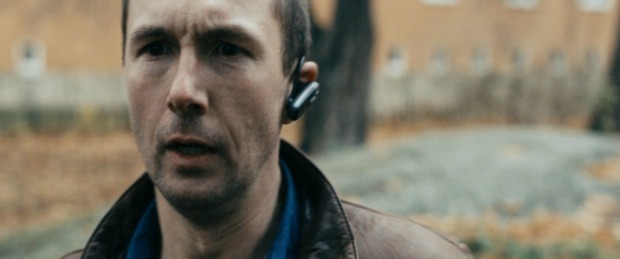The Ape
Unable to coherently vocalise his inner thoughts, or successfully communicate with any other humans, Krister resorts to wild outbursts of frantic, flailing violence.
Plot summary
A descent into hell, Jesper Ganslandt's disturbing and suspenseful second feature begins with a man waking up in unfamiliar surroundings, only to find the life he knew the day before is gone.

Krister, father and husband, awakes in a bloody sprawl on the floor of an unfamiliar bathroom. Frantically gathering himself into some state of semblance, he departs and resolves to continue the routines of the day as normal. As the lank winter day lazily unfurls, his behaviour becomes increasingly more erratic and brutal. Each of the day’s routines seem to tempt him closer to blowing. Ganslandt’s camera is constantly behind his shoulder, the background always a dull blur. Krister’s paranoia – whatever is causing it – is manifest throughout: an insistent, claustrophobic migraine. He tries to vent his furiously compact rage through playing tennis, buying power tools and teaching a driving lesson – all of which are indescribably difficult to watch; within snatching distance of a tennis racquet, circular saw or nervous driving student, Krister is like a burning stick of dynamite, only balding, late-thirties and Swedish.
As the true nature of Krister’s torment is unexpectedly thrown into stark relief, Ganslandt only invites us to make our own presumptions as to what exactly occurred, never allowing us the satisfaction of knowing for sure. Instead, we are forced to share a portion of Krister’s manic frustration, guilt, anger and blood-chilling panic for one day. The performance really rests on Olle Sarri as the Ape himself.
The title pertains to the behaviour of our disturbed lead; not able to coherently vocalise his inner thoughts, or successfully communicate with any other humans, he resorts to wild outbursts of frantic, flailing violence. The sinews along his jaw grow more and more pronounced as molars grind away masochistically, like machines. Almost perpetually on the point of hyperventilating, Sarri somehow manages to confer some of Krister’s stomach-knotting panic over to us. And it’s not a pleasant experience. Perhaps the most disturbing facet to Sarri’s exceedingly proficient acting is his eyes – seething, pained, menacing and dead all at once.
The key to this film is how it places you uncomfortably close to a clearly disturbed and distressed man whose actions are impossible to second guess. Moreover, our position as empathic audience member is a troubled one; it isn’t a simple case of either sympathy or antipathy. The emotions at work here both on the screen and within the audience are not tangible, not easily expressed and certainly not singular. The overall effect of this – much like the gas-leak background – is a fuzzy, grizzly maelstrom of conflict, condemnation and intense sympathy.
Ganslandt’s film is full of Hitchcockian tension – an antidote to contemporary horror film dross that gets excreted these days. Two moments in particular will have you wincing in dreadful anticipation, one involving his mother and the other a high-speed train. Here is a director who knows how to turn the screw, often with alarming verve. The music for instance – all diegetic – is truly terrifying; on Krister’s many car journeys, we witness this highly unstable man hurtling through the snowy outskirts of some rundown Swedish city listening to very loud, crass, mainstream American RnB – a further troubling refraction of the Ape’s deranged psyche.











COMMENTS